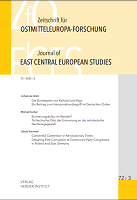Die Domkapitel von Kurland und Riga. Ein Beitrag zum Inkorporationsbegriff im Deutschen Orden
The Cathedral Chapters of Courland and Riga. A Study on the Concept of Incorporation in the Teutonic Order
Author(s): Johannes GötzSubject(s): Christian Theology and Religion, History of Church(es), Military history, Politics and religion, Canon Law / Church Law
Published by: Verlag Herder-Institut
Keywords: Cathedral Chapter; Livonia; Teutonic Order; Riga; Courland; Prussia;
Summary/Abstract: Research on the cathedral chapters of the ecclesiastical province of Riga shows that the Teutonic Order played a significant role in how they operated, since five of the eight cathedral chapters were regulated according to its rule. These five are referred to in the literature as cathedral chapters that were incorporated into the Teutonic Order. This goes back to the source term “incorporation,” which, however, is misleading, because in each case, that was not an incorporation in the sense of canon law. Research has therefore attempted to explain how the concept of incorporation is to be understood and how the relationship between the cathedral chapters and the leadership of the Order is to be evaluated. So far, this has been presented primarily through the examples of the Prussian Teutonic Order cathedral chapters of Samland, Pomesania and Kulm. This article focuses on the Livonian Teutonic Order cathedral chapters of Riga and Courland in order to introduce them into the research discussion on the concept of incorporation. Evaluating the “incorporation” of the cathedral chapters of Courland and Riga, involves, firstly, tracing the respective legal frameworks and, secondly, contextualizing the most important rights of the Livonian master of the Teutonic Order—canonical visitation and participation in the election of canons. It can be observed that canonical visitation in fact played no role, but only the rights of the master to participate in the election of canons were of importance. The cathedral chapters of Courland and Riga, however, are characterized by the fact that there were hardly any institutional connections with the Livonian branch of the Teutonic Order and a duty of obedience of the canons towards the superiors of the Order did not, in fact, exist. Consequently, in the future, the term “incorporation” should be avoided in the literature, since it on the one hand can only be found in documents influenced by the Teutonic Order and thus the term stands for the self-perception of the Order; on the other hand it distorts the view of these cathedral chapters in general.
Journal: Zeitschrift für Ostmitteleuropa-Forschung
- Issue Year: 72/2023
- Issue No: 3
- Page Range: 325-376
- Page Count: 52
- Language: German

